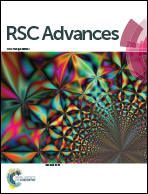Glycerol: a more benign and biodegradable promoting medium for catalyst-free one-pot multi-component synthesis of triazolo[1,2-a]indazole-triones†
Abstract
The one-pot three component synthesis of triazolo[1,2-a]indazole-triones was conducted successfully under catalyst-free conditions in glycerol as a benign, nontoxic and biodegradable promoting medium. A broad range of substrates including aromatic aldehydes are condensed with carbonyl compounds possessing a reactive α-methylene group and urazole derivatives. All reactions are completed in short times and the products are obtained in good to excellent yields. Moreover, presented method was applied successfully to the large scale synthesis of title compounds.
![Graphical abstract: Glycerol: a more benign and biodegradable promoting medium for catalyst-free one-pot multi-component synthesis of triazolo[1,2-a]indazole-triones](/en/Image/Get?imageInfo.ImageType=GA&imageInfo.ImageIdentifier.ManuscriptID=C5RA13805A&imageInfo.ImageIdentifier.Year=2015)

 Please wait while we load your content...
Please wait while we load your content...